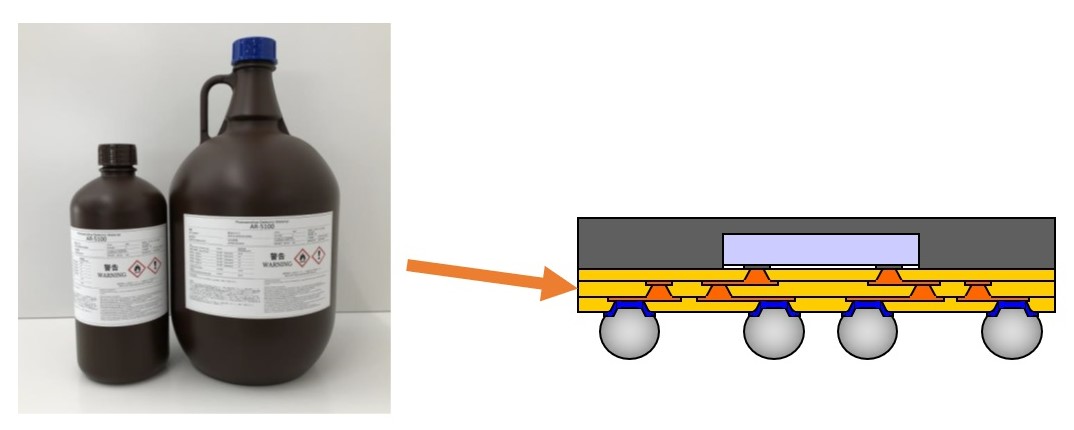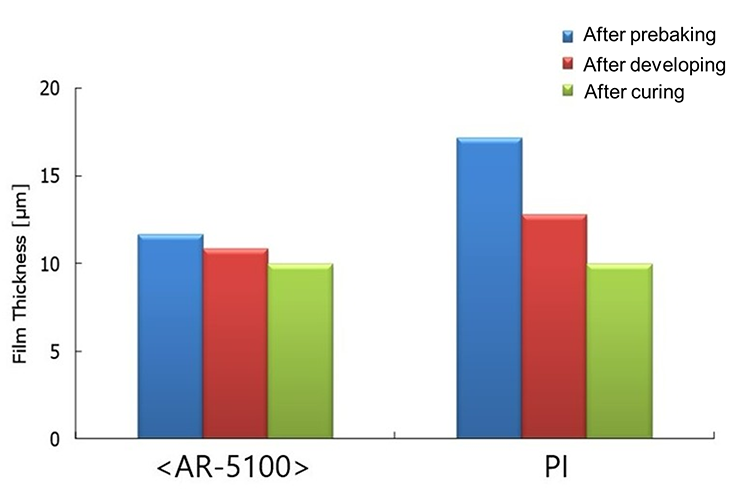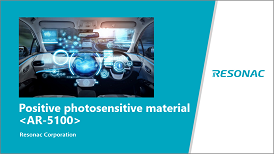- Category:
- Tag:
Applicable Business AreasVehicle-mounted electronic component manufacturers, semiconductor packaging makers
Target ApplicationsFOWLP RDLs for in-vehicle ADAS or smartphone electronic devices
Applicable Business AreasVehicle-mounted electronic component manufacturers, semiconductor packaging makers
Target ApplicationsFOWLP RDLs for in-vehicle ADAS or smartphone electronic devices

The demand for high performance, compact, and low-cost in semiconductor devices or electrical equipment is ever-increasing, whether they are smartphone processors or automotive components. The technology drawing attention as a useful solution is FOWLP (Fan Out Wafer Level Package). Using the technology of semiconductor front-end process, FOWLP enables to re-distribute I/O to spread outside of chip area by redistribution layer (RDL) and as a result to increase the size of the ultra-fine spacing between IC terminals to the size of printed wiring boards. FOWLP does not require package substrates and the technology also contributes to increasing the frequency because it can reduce package thickness or wire length.
Photosensitive insulating materials for RDL are required to satisfy various demands, including low warpage, high reliability, compatibility with redistribution wiring and higher resolution for finer redistribution wiring.
Conventionally, polyimide has been used as an RDL material, but is now expected inadequate for achieving high resolution with increasingly minute redistribution. Also because of growing environmental awareness in recent years, the use of polyimide, which contains NMP as a solvent and requires an organic solvent developer, is raising concerns.
As an alternative solution, Resonac proposes its NMP-free FOWLP RDL material <AR-5100> as a positive photosensitive material that achieves high resolution and applicable with aqueous developer.

<AR-5100> is used in FOWLP redistribution layers (RDLs)
Polyimide resolution is considered problematic for mainly two reasons: it is a negative photosensitive material, and large film loss during processing. In patterning with a negative photosensitive material, radicals generated by exposure induce cross-linking and make the exposed parts insoluble in an organic solvent developer, but there is concern that the radicals disperse outside the exposed parts. Fine patterning is also difficult with a negative photosensitive material because the solvent causes the insoluble parts to swell during developing. The sizable film loss with polyimide after development also requires a thick coating, which in turn creates various challenges related to the aspect ratio and makes it harder to achieve high resolution.
Resonac’s <AR-5100> is a positive photosensitive material. In patterning with a positive photosensitive material, the exposed parts become soluble in an alkaline developer by photosensitive reaction. Positive photosensitive materials do not have concern such as radical diffusion pf negative type, and they are also known to have less swelling of insoluble parts in the developer. Resonac’s <AR-5100> is also advantageous in that it has less film loss, which allows finer patterning and greater margins of exposure conditions that contribute to lower processing costs. <AR-5100> makes it possible to control the shape of the pattern after curing as well.
Insulating materials for RDL are expected to meet a broad range of requirements, such as low stress, low warpage, high reliability, compatibility with redistribution wiring, low-temperature curing, and uniformity of film thickness. Resonac has satisfied these requirements by optimizing the material’s composition.
For details, please refer to the data below and technical documents. <AR-5100> is NMP-free and alkaline-developable, thus meeting the environmental concerns of customers.
| Item | Unit | <AR-5100> |
|---|---|---|
| Cure temperature | deg.C | 230 |
| Tensile strength | MPa | 160 |
| Elongation | % | 60 |
| Young modulus | GPa | 2.4 |
| Tg | deg.C | 253 |
| CTE | ppm/deg.C | 49 |
| Residual stress | MPa | 18 |
| Dk/Df(@10GHz) | ― | 3.3/0.03 |
Polyimide is known to cause significant film loss after development and cure, reducing the film thickness to approximately 60 percent. As shown in the example below, an initial thickness of 17μm is required to achieve 10μm-thick openings after processing, which makes it difficult to manage the high aspect ratios and achieve good resolution. With Resonac’s <AR-5100> able to reduce film loss, a 12μmt coating is sufficient to achieve 10μmt, and finer patterning becomes possible with the same aspect ratio. Wider margins of exposure conditions also contribute to processing cost reduction.

As shown in the figure below, <AR-5100> enables control of pattern shape after curing by adjusting the curing process, and can be used for various structures, including through-hole electrode or bump structures.
Insulating materials for RDL are expected to satisfy various requirements such as low stress, low warpage, high reliability, compatibility with redistribution wiring, low-temperature curing, and uniformity of film thickness. Especially, adhesion strength to Cu and crack resistance under thermal cycle test is required. Resonac has improved these features by optimizing the material’s composition and achieved high reliability as shown in the figure below. Until 1000 cycles, no crack or delamination was observed under Thermal cycle test.

Test Substrate
Please feel free to contact us about application to WLCSP.
Update date: 26th June, 2023

Contact Us
Please don't hesitate to contact us if you have any questions.